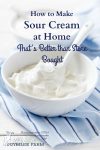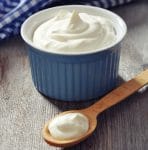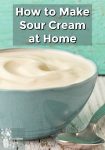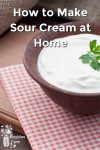Description
Use this as you would store-bought sour cream on baked potatoes, in stroganoff, as an accompaniment to potato pancakes, as a base for dips or sauces. Once you’ve tasted active, probiotic-rich, creamy homemade sour cream, you’ll never enjoy the commercial product again
Ingredients
- 2 cups of organic, grass-fed heavy cream or half ‘n’ half
- 2 tablespoons of active culture plain yogurt
- ½ teaspoon of mesophilic culture or 2 tablespoons of active cultured buttermilk, or 2 tablespoons milk kefir
- A wide mouth quart mason jar with a lid
Instructions
Step 1: Clean and sanitize both the jar, the lid, and any utensils that will come in contact with the cream.
Step 2: Pour the cream into the sanitized jar. Using a sanitized spoon, stir in ½ teaspoon of the powdered mesophilic culture or 2 tablespoons of the active cultured buttermilk, and 2 tablespoons of yogurt OR omit the mesophilic culture and yogurt and just add 2 tablespoons of kefir. Stir well. Put the lid on the jar.
Step 3: Create a warm environment to culture the sour cream, as you would if you were culturing yogurt. I place a 2-quart glass measuring cup in the oven and put about 1 liter of hot tap water into it. Place the covered jar in this and put it in the oven on the middle rack. Turn the oven light on and close the door. The oven maintains a temperature around 95 to 115 F which is ideal for dairy ferments.
Step 4: Leave the sour cream to ferment overnight – 8 to 12 hours. As it ferments it will thicken and the flavor will improve.
Step 5: Refrigerate the finished sour cream.
Notes
You can make sour cream at room temperature on the kitchen counter, but a better tasting and more active culture will result from fermenting it overnight in a warm environment. This encourages the proliferation of both mesophilic and thermophilic lacto-bacteria, giving you more probiotics and more complex flavor for the same effort.





